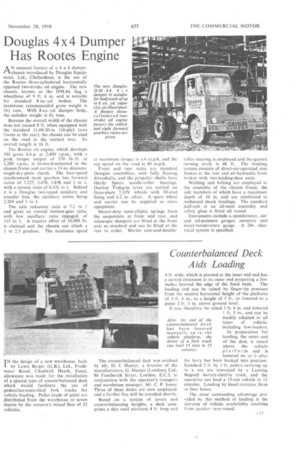Douglas 4 x 4 Dumper Has Rootes Engine
Page 63

If you've noticed an error in this article please click here to report it so we can fix it.
AN unusual feature of a 4 x 4 dumper chassis introduced by Douglas Equipment, Ltd., Cheltenham, is the use of the Rootes three-eylindered horizontally opposed two-stroke oil engine. The new chassis, known as the DM.44, ha, a wheelbase of 9 ft. 6 in. and is suitable for standard 8-cu.-yd. bodies. The maximum recommended gross weight is 161 tons, With 8-cu.-yd. dumper body. the unladen weight is 6 tons.
Because the overall width of the chassis does not exceed 8 ft, when equipped with the standard 11.00-20-in. (16-ply) tyres (twins at the rear), the chassis can be used on the road in the normal way. Its overall length is 16 ft.
The Routes oil engine, which develops 105 gross b.h.p. at 2400 r.p.m., with a peak torque output of 270 lb.-ft. at 1.200 r.p.m., is forward-mounted in the chassis frame and carries a 13-in.-diameter single-dry-plate clutch. The four-speed synchromesh main gearbox has forward ratios of 7.227, 3.478, 1.838 and 1 to 1, with a reverse ratio of 8.431 to 1. Behind it is a Douglas two-speed auxiliary and transfer box, the auxiliary ratios being 2.204 and 1 to 1.
The axle reduction ratio is 7.2 to 1 and gives an overall bottom-gear ratio, with low auxiliary ratio engaged, of 115 to 1. A tractive effort of 16,000 lb. is claimed and the chassis can climb a 1 in 2.5 gradient. The minimum speed TN the design of a new warehouse, built by Lewis Berger (G.B.), Ltd., Freshwater Road, Chadwell Heath, Essex. allowance was made for the installation of a special type of counterbalanced deck which would facilitate the use of pedestrian-controlled fork trucks for vehicle loading. Pallet loads of paint are distributed from the warehouse to seven depots by the concern's mixed fleet of 25 vehicles. at maximum torque is 1.4 m.p.h. and the top speed on the road is 40 m.p.h.
Front and rear axles are standard Douglas assemblies, with fully floating driveshafts, and the propeller shafts have Hardy Spicer needle-roller bearings. Dunlop Trak grip tyres are carried On three-piece 7.33V wheels with 10-stud axing and 6.2 in. offset. A spare wheel and carrier can he supplied as extra equipment.
Heavy-duty semi-elliptic springs form the suspension at front and rear, and telescopic dampers are fitted at the front axle as standard and can be fitted at the rear to order. Marles cam-and-double The counterbalanced deck was evolved by Mr. D. J. Hunter, a director of the manufacturers, G. Hunter (London), Ltd.. 80 Fenchurch Street, London, E.C.3, in conjunction with the operator's transport and warehouse manager, Mr. C. P. Jones. Three of these decks are now employed. and a further five will be installed shortly.
Based on a system of levers and counterbalancing weights, a deck comprises a thin steel platform 8 ft. long and roller steering is employed and the quoted turning circle is 48 ft. The braking system consists of direct-air-operated cam brakes at the rear and air-hydraulic front brakes with two-leading-shoe units.
Welding and bolting are employed in the assembly of the chassis frame, the side members of which have a maximum depth of 10 in. and are reinforced to withstand shock loadings. The standard half-cab is an all-steel assembly and safety glass is fitted all round.
Instruments include a speedometer, airand oil-pressure gauges, ammeter and water-temperature gauge. A 24v. electrical system is specified.












































































































